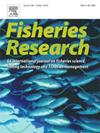菲律宾西北部Pangasinan Bolinao多物种海洋无脊椎动物渔业生产30年来的变化(1992-2023)
IF 2.2
2区 农林科学
Q2 FISHERIES
引用次数: 0
摘要
海洋无脊椎动物,其中许多是采集的,是日常饮食的一部分,并为菲律宾吕宋岛西北部邦加西南的Bolinao农村沿海家庭提供收入。在2023年2 - 5月进行了为期4个月的每日市场调查,并与1992-1993年的市场数据进行了比较,以确定30年后物种组成、数量和估价值的变化。两次调查共记录到63种,但物种组成各不相同。2023年,野生捕获和养殖无脊椎动物的相对丰度增加,而采集物种的相对丰度下降。2023年2月至5月在当地市场销售的无脊椎动物达到了3080万吨,价值约600万菲律宾比索(108,635美元)。年销量估计为7690万吨,价值约1490万菲律宾比索(271587美元)。这还不包括渔民家庭直接消费的数量和运往外部市场的高价值物种(如海参、海胆籽、龙虾)。生产数据的比较表明,甲壳类和软体动物的体积下降了61.4% %,相应的价值下降了17.8% %。在一些地方,一些腹足类、双壳类和甲壳类动物不再被采集。一些地点的产量下降可归因于过度捕捞、环境退化和最近的沿海发展项目。当地旅游业和通往外部市场的道路改善也可能影响了当地市场销量的下降。为了可持续地利用无脊椎动物资源,必须实施渔业管理,特别是在无脊椎动物产量高但易受环境退化影响的地区。本文章由计算机程序翻译,如有差异,请以英文原文为准。
Changes in the multi-species marine invertebrate fishery production in Bolinao, Pangasinan, northwestern Philippines after 30 years (1992–2023)
Marine invertebrates, many of which are gleaned, are part of the regular diet and provide income to rural coastal households in Bolinao, Pangasinan in northwestern Luzon, Philippines. A four-month daily market survey was conducted from February–May 2023 and compared with market data in 1992–1993 to determine changes in species composition, volume and estimated value after 30 years. A total of 63 species were recorded, but species composition varied between the two surveys. The relative abundance of wild-caught and cultured invertebrates increased but that of gleaned species decreased in 2023. Invertebrates sold in the local market in February–May 2023 reached a volume of 30.8 MT worth ∼Php 6 million (USD 108,635). The annual volume was estimated at 76.9 MT worth ∼Php 14.9 million (USD 271,587). This does not include the amount directly consumed by fisher households and high-value species (e.g., sea cucumbers, sea urchin roe, lobsters) transported to outside markets. Comparison of production data suggests 61.4 % decline in the volume of crustaceans and mollusks, corresponding to 17.8 % decrease in value. Several gastropods, bivalves and crustaceans are no longer collected in some sites. The decline in production in some sites could be attributed to overfishing, environmental degradation and recent coastal development projects. Local tourism and improved roads to outside markets may have also influenced the decrease in the volume sold in the local market. To sustainably utilize invertebrate resources, fisheries management must be implemented, especially in areas with high invertebrate production but vulnerable to environmental degradation.
求助全文
通过发布文献求助,成功后即可免费获取论文全文。
去求助
来源期刊

Fisheries Research
农林科学-渔业
CiteScore
4.50
自引率
16.70%
发文量
294
审稿时长
15 weeks
期刊介绍:
This journal provides an international forum for the publication of papers in the areas of fisheries science, fishing technology, fisheries management and relevant socio-economics. The scope covers fisheries in salt, brackish and freshwater systems, and all aspects of associated ecology, environmental aspects of fisheries, and economics. Both theoretical and practical papers are acceptable, including laboratory and field experimental studies relevant to fisheries. Papers on the conservation of exploitable living resources are welcome. Review and Viewpoint articles are also published. As the specified areas inevitably impinge on and interrelate with each other, the approach of the journal is multidisciplinary, and authors are encouraged to emphasise the relevance of their own work to that of other disciplines. The journal is intended for fisheries scientists, biological oceanographers, gear technologists, economists, managers, administrators, policy makers and legislators.
 求助内容:
求助内容: 应助结果提醒方式:
应助结果提醒方式:


